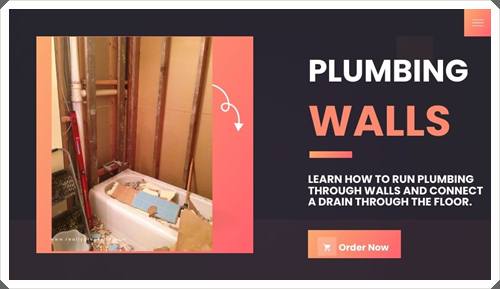How to Run Pipes Through Walls and Floors for DIY Plumbing Work
If you’re amateur operating pipes, we’ll guide you to guide your plumbing wall through the most challenging places.
The pipes that supply water to toilets, faucets, showers and other fixtures are usually concealed behind walls or under flooring, which requires careful planning to ensure proper installation. After you’ve created a plan for the new plumbing, developing an approach to operating the pipes is essential. This is simple if you’re building a new structure or addition in which the framing is visible. However, if you’re renovating a bath or kitchen area, you must be prepared to change the design once you remove the flooring and wall covering.
Replacing the finished surface when plumbers (especially the patching of walls) typically takes a few days. Repairing large wall patches (or even replacing the entire wall) will take a little longer than a tiny patch, so make sure you have ample space for work.
After you have opened the drain and vent lines, connecting the supply, which is usually along drain-waste-vent (DWV) pipelines, is fairly simple. Before beginning, you should brush up on your carpentry basics, understand your home’s layout and ensure you know the best way to install pipes. It’s important to get your plans approved by your municipal building inspector to ensure they conform to the plumbing code.
Instructions
How to Run Pipes Through Walls and Floors
Every home renovation, expansion, or construction that requires plumbing typically involves using pipes. Learn to navigate difficult places on walls and floors with these tips.
1. Assess and Remove the Wall
If you plan to install an additional stack, look at the framing. A toilet installation requires a drain of 3 inches that can be put in only if the wall is constructed of 2x6s or more (a 2-inch pipe can be installed through a wall of 2×4). Take the wall’s surface and move it to the ceiling.
2. Prep for New Pipe
Make a hole, allowing extra room in the newly installed pipe. For a pipe of 3 inches, use an electric drill and a reciprocating cut to cut a hole approximately 4 1/4 inches wide by 10 inches in both the floor of the room that you’re working in and on top of that room beneath. Cut off a 10-inch by 2 feet section of flooring.
Read More : Exploring the Pros and Cons of Pebble Shower Flooring
3. Assemble and Place Drainpipe
Attach the fittings to on top of the Drainpipe. Make sure they face in the right direction. The Drainpipe should be larger than the one you need. You can cut it down to size in the future from below. Slide the pipe through the hole.
4. Run the Vent
You may need to cut an opening in the wall over or below it to direct the vent pipe upwards or down. You can connect the vent to join the existing ventilation in the attic. If not, you can drill through the ceiling of your attic and let an expert roofer install an attic roof jack to connect your vent pipe.
5. Guide and Attach Pipes
The Drainpipe is secured with straps. Make a smaller hole in the ceiling to accommodate the pipe vent. If you want a 1 1/2-inch vent pipe, it is recommended that a 2 1/2-inch hole will suffice. The vent pipe is guided up through the hole into the attic or room above, then slid its lower part into the fitting near the floor.
Drainpipes that run through joists call for a meticulous job. The holes should follow an exact path across the flooring. Then, they have to be either ascending or descending so that the pipe is sloped 1/4 inch for each foot. (If the joists measure 16 inches across and pipes are running across them at an angle of right, the holes are different in height by around 3/8 inches.)
Vent pipes may run in a straight line. However, certain codes require an incline towards the primary drain. Every drain line must be sloped. For a precise slope, mark a level line on the studs, and then measure 1/4-inch for each running foot. Also, codes could require fireproof caulk for walls.
Read More : How to Determine the Shower Faucet Type
6. How to Stabilize and Protect Pipes
When you can, put pipes through the holes in the center of the framing member, and line the holes with felt or wood shims to prevent pipes from shaking and rattling. Place a shim beneath the pipe, then tap it until it is in position but not completely tight to allow expansion. If nodes are required, make them as tiny as possible since they weaken the framing member. Metal plates to shield the pipes against nails.
7. Tips for Running Pipe Through a Floor
The passage of drainpipes through joists calls for a meticulous job. The holes should follow an exact line across the floor. They must ascend or descend, so the pipe is sloped 1/4 inch for each foot. (If the joists measure 16 inches in diameter and pipes are running across them at an angle of right, the holes are different in height by 3/8 inches.)
8. Tips for Running Pipe Through a Wall
Vent pipes may run at a level, but certain codes require an incline towards the drain that is used for the main drainage. Drain lines should be sloped. To determine a slope precisely, draw a level line on the studs and then measure 1/4-inch for each running foot. Be aware that codes may require fireproof caulking on walls.

Leave a Reply